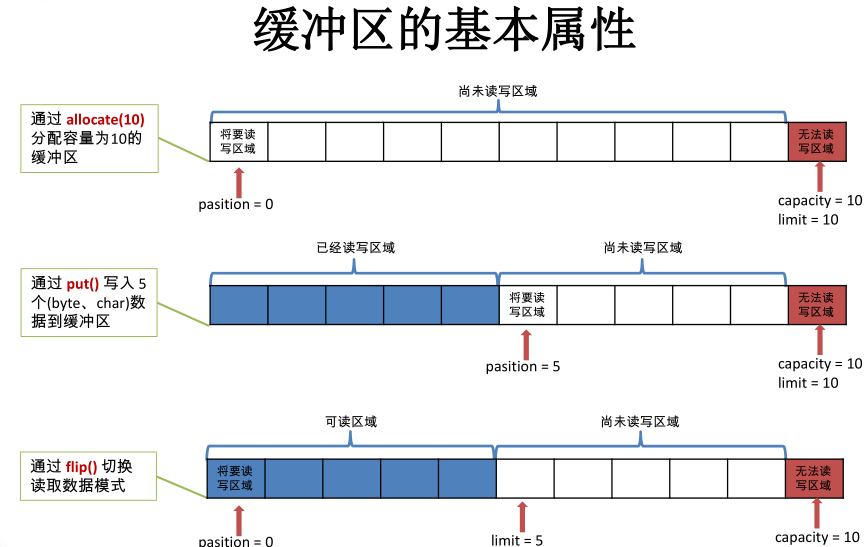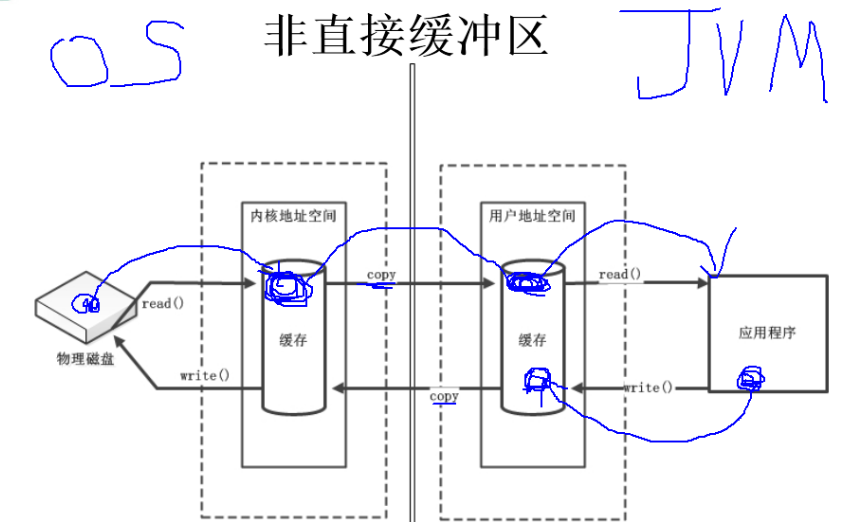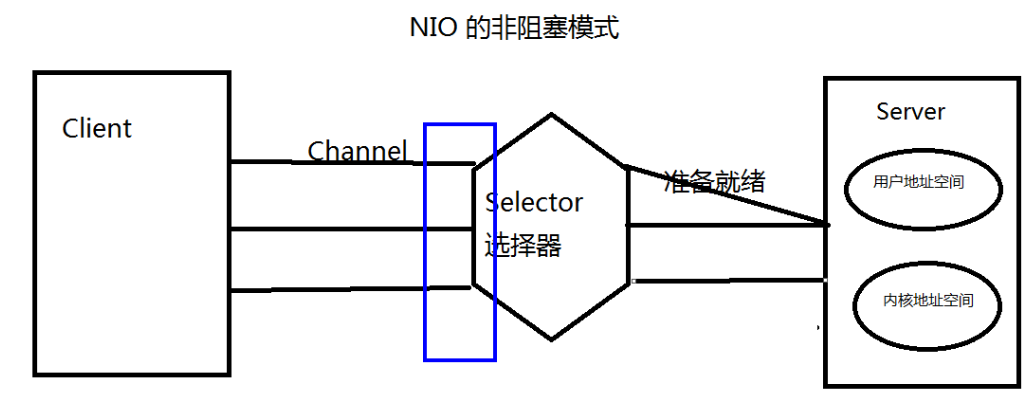常见概念
通道(channel):相当于铁路,负责连接,打开IO设备(文件、套接字)的连接。
缓冲区(buffer):负责数据存储,底层就是数组,可以存数不同数据类型的数据。
buffer四个核心属性:
- capacity:buffer的容量,表示缓冲区中最大的容量
- position: 缓冲区中正在操作的位置 0《mark《 position《limit《capacity
- limit:表示缓冲区中可以操作数据的大小(limit 后面的数据不能读写).
- mark: 示使用mark()方法记录当前position的位置,reset()方法可以把position恢复到mark的位置.

package com.buffer;
import java.nio.ByteBuffer;
import org.junit.Test;
public class TestBuffer {
@Test
public final void test()
{
ByteBuffer buffer = ByteBuffer.allocate(1024);
System.out.println(buffer.position());
System.out.println(buffer.limit());
System.out.println(buffer.capacity());
buffer.put("abcde".getBytes());
System.out.println("-----------");
System.out.println(buffer.position());
System.out.println(buffer.limit());
System.out.println(buffer.capacity());
buffer.flip(); //切换到读取模式
System.out.println("-----------");
System.out.println(buffer.position());
System.out.println(buffer.limit());
System.out.println(buffer.capacity());
}
}
直接缓冲区和非直接缓冲区
- 非直接缓冲区:通过allocate()方法分配缓冲区,将缓冲区建立在JVM的内存中。
- 直接缓冲区:通过allocateDiect()方法分配直接缓冲区,将缓冲区建立在物理内存中,提高效率

字符集 Charset
- 编码: 字符串->字符数组
- 解码:字符数组->字符串
阻塞和非阻塞
- 传统的 IO 流都是阻塞式的。也就是说,当一个线程调用 read() 或 write() 时,该线程被阻塞,直到有一些数据被读取或写入,该线程在此期间不 能执行其他任务。因此,在完成网络通信进行 IO 操作时,由于线程会 阻塞,所以服务器端必须为每个客户端都提供一个独立的线程进行处理, 当服务器端需要处理大量客户端时,性能急剧下降。
- Java NIO 是非阻塞模式的。当线程从某通道进行读写数据时,若没有数 据可用时,该线程可以进行其他任务。线程通常将非阻塞 IO 的空闲时 间用于在其他通道上执行 IO 操作,所以单独的线程可以管理多个输入 和输出通道。因此,NIO 可以让服务器端使用一个或有限几个线程来同 时处理连接到服务器端的所有客户端。

阻塞式IO
package com.buffer;
import java.io.IOException;
import java.net.InetSocketAddress;
import java.nio.ByteBuffer;
import java.nio.channels.FileChannel;
import java.nio.channels.ServerSocketChannel;
import java.nio.channels.SocketChannel;
import java.nio.file.Paths;
import java.nio.file.StandardOpenOption;
import org.junit.Test;
/**
* 一.使用NIO完成网络通信的三个核心: 1. 通道(channel):负责连接 SelectableChannel socketChannel
* ServerSocketChannel DatagramChannel 2. 缓冲区(buffer):负责数据存储
* 3.选择器(selector):监控channel的状况
*
*/
public class BlockingIo {
/**
* 客户端发送图片
*
* @throws IOException
*/
@Test
public void client() throws IOException {
SocketChannel socketChannel = SocketChannel.open(new InetSocketAddress("127.0.0.1", 9889));
FileChannel inChannel = FileChannel.open(Paths.get("java-nio-selector.png"), StandardOpenOption.READ);
ByteBuffer buffer = ByteBuffer.allocate(1024);
while (inChannel.read(buffer) != -1) {
buffer.flip();
socketChannel.write(buffer);
buffer.clear();
}
socketChannel.close();
inChannel.close();
}
@Test
public void server() throws IOException {
ServerSocketChannel ssChannel = ServerSocketChannel.open();
FileChannel outChannel = FileChannel.open(Paths.get("2.png"), StandardOpenOption.WRITE,
StandardOpenOption.CREATE);
ssChannel.bind(new InetSocketAddress(9889));
SocketChannel sChannel = ssChannel.accept();
ByteBuffer buf = ByteBuffer.allocate(1024);
while (sChannel.read(buf) != -1) {
buf.flip();
outChannel.write(buf);
buf.clear();
}
ssChannel.close();
sChannel.close();
outChannel.close();
}
}
非阻塞
package com.buffer;
import java.io.IOException;
import java.net.InetSocketAddress;
import java.nio.ByteBuffer;
import java.nio.channels.SelectionKey;
import java.nio.channels.Selector;
import java.nio.channels.ServerSocketChannel;
import java.nio.channels.SocketChannel;
import java.util.Date;
import java.util.Iterator;
import java.util.Scanner;
import org.junit.Test;
/*
* 一、使用 NIO 完成网络通信的三个核心:
*
* 1. 通道(Channel):负责连接
*
* java.nio.channels.Channel 接口:
* |--SelectableChannel
* |--SocketChannel
* |--ServerSocketChannel
* |--DatagramChannel
*
* |--Pipe.SinkChannel
* |--Pipe.SourceChannel
*
* 2. 缓冲区(Buffer):负责数据的存取
*
* 3. 选择器(Selector):是 SelectableChannel 的多路复用器。用于监控 SelectableChannel 的 IO 状况
*
*/
public class TestNonBlockingNIO {
//客户端
@Test
public void client() throws IOException{
//1. 获取通道
SocketChannel sChannel = SocketChannel.open(new InetSocketAddress("127.0.0.1", 9898));
//2. 切换非阻塞模式
sChannel.configureBlocking(false);
//3. 分配指定大小的缓冲区
ByteBuffer buf = ByteBuffer.allocate(1024);
//4. 发送数据给服务端
Scanner scan = new Scanner(System.in);
while(scan.hasNext()){
String str = scan.next();
buf.put((new Date().toString() + "\n" + str).getBytes());
buf.flip();
sChannel.write(buf);
buf.clear();
}
//5. 关闭通道
sChannel.close();
}
//服务端
@Test
public void server() throws IOException{
//1. 获取通道
ServerSocketChannel ssChannel = ServerSocketChannel.open();
//2. 切换非阻塞模式
ssChannel.configureBlocking(false);
//3. 绑定连接
ssChannel.bind(new InetSocketAddress(9898));
//4. 获取选择器
Selector selector = Selector.open();
//5. 将通道注册到选择器上, 并且指定“监听接收事件”
ssChannel.register(selector, SelectionKey.OP_ACCEPT);
//6. 轮询式的获取选择器上已经“准备就绪”的事件
while(selector.select() > 0){
//7. 获取当前选择器中所有注册的“选择键(已就绪的监听事件)”
Iterator<SelectionKey> it = selector.selectedKeys().iterator();
while(it.hasNext()){
//8. 获取准备“就绪”的是事件
SelectionKey sk = it.next();
//9. 判断具体是什么事件准备就绪
if(sk.isAcceptable()){
//10. 若“接收就绪”,获取客户端连接
SocketChannel sChannel = ssChannel.accept();
//11. 切换非阻塞模式
sChannel.configureBlocking(false);
//12. 将该通道注册到选择器上
sChannel.register(selector, SelectionKey.OP_READ);
}else if(sk.isReadable()){
//13. 获取当前选择器上“读就绪”状态的通道
SocketChannel sChannel = (SocketChannel) sk.channel();
//14. 读取数据
ByteBuffer buf = ByteBuffer.allocate(1024);
int len = 0;
while((len = sChannel.read(buf)) > 0 ){
buf.flip();
System.out.println(new String(buf.array(), 0, len));
buf.clear();
}
}
//15. 取消选择键 SelectionKey
it.remove();
}
}
}
}